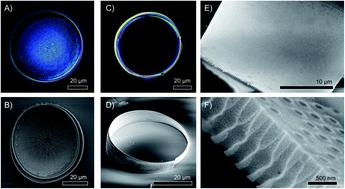当前位置:
X-MOL 学术
›
Faraday Discuss.
›
论文详情
Our official English website, www.x-mol.net, welcomes your
feedback! (Note: you will need to create a separate account there.)
Biosilica slab photonic crystals as an alternative to cleanroom nanofabrication?
Faraday Discussions ( IF 3.3 ) Pub Date : 2020-05-27 , DOI: 10.1039/d0fd00031k Johannes W Goessling 1 , Ana A Santiago González 1 , Vijaya Shanthi Paul Raj 2 , Matt P Ashworth 3 , Schonna R Manning 3 , Martin Lopez-Garcia 1
Faraday Discussions ( IF 3.3 ) Pub Date : 2020-05-27 , DOI: 10.1039/d0fd00031k Johannes W Goessling 1 , Ana A Santiago González 1 , Vijaya Shanthi Paul Raj 2 , Matt P Ashworth 3 , Schonna R Manning 3 , Martin Lopez-Garcia 1
Affiliation

|
Photonics, the manipulation of light at nanoscale, is a key enabling technology with impact in health and energy applications, among others. In most cases photonics still relies on materials and fabrication methods inherited from other disciplines, usually requiring expensive, time-consuming and environmentally-unfriendly processes. Recent experiments demonstrated that advanced photonic materials, as complex as those known as 2.5 dimensional slab photonic crystals, also occur naturally in diatoms. These microscopic algae precipitate silicic acid from water to produce silicon dioxide membranes, relying on intracellular biomineralization mechanisms. Addressing some important aspects for the potential industrial utilization of these structures, we here propose that optical materials produced by the diatoms could serve as cost-effective and environmentally friendly alternatives to cleanroom nanofabrication. We demonstrate that photonic materials grown by the diatom species Coscinodiscus granii can be separated based on its hydrokinetic characteristics. We further show that the photonic membranes present low defect rates of ca. 1/100 unit cells and that variation in pore diameter, as observed between individual membranes, can affect the photonic properties at large, but only marginally at low refractive index contrast. Finally, we list algal culture collections operating worldwide, thus providing a global network for live diatoms and diatom materials. We discuss the feasibility and bottlenecks related to scaled-up growth for direct utilization of photonic materials from diatoms.
中文翻译:

生物二氧化硅平板光子晶体作为洁净室纳米制造的替代品?
光子学,即在纳米尺度上操纵光,是对健康和能源应用等产生影响的关键使能技术。在大多数情况下,光子学仍然依赖于从其他学科继承而来的材料和制造方法,通常需要昂贵、耗时且不环保的工艺。最近的实验表明,先进的光子材料,与已知的 2.5 维平板光子晶体一样复杂,也自然存在于硅藻中。这些微小的藻类依靠细胞内生物矿化机制从水中沉淀硅酸以产生二氧化硅膜。解决这些结构潜在工业利用的一些重要方面,我们在此建议由硅藻生产的光学材料可以作为洁净室纳米制造的具有成本效益和环保的替代品。我们证明了硅藻物种生长的光子材料Coscinodiscus granii可以根据其流体动力学特性进行分离。我们进一步表明,光子膜的缺陷率很低。1/100 单位细胞和孔径的变化,如在单个膜之间观察到的,可以在很大程度上影响光子特性,但仅在低折射率对比度下微不足道。最后,我们列出了在全球范围内运营的藻类培养物保藏中心,从而为活硅藻和硅藻材料提供了一个全球网络。我们讨论了与直接利用硅藻光子材料的规模化增长相关的可行性和瓶颈。
更新日期:2020-07-29
中文翻译:

生物二氧化硅平板光子晶体作为洁净室纳米制造的替代品?
光子学,即在纳米尺度上操纵光,是对健康和能源应用等产生影响的关键使能技术。在大多数情况下,光子学仍然依赖于从其他学科继承而来的材料和制造方法,通常需要昂贵、耗时且不环保的工艺。最近的实验表明,先进的光子材料,与已知的 2.5 维平板光子晶体一样复杂,也自然存在于硅藻中。这些微小的藻类依靠细胞内生物矿化机制从水中沉淀硅酸以产生二氧化硅膜。解决这些结构潜在工业利用的一些重要方面,我们在此建议由硅藻生产的光学材料可以作为洁净室纳米制造的具有成本效益和环保的替代品。我们证明了硅藻物种生长的光子材料Coscinodiscus granii可以根据其流体动力学特性进行分离。我们进一步表明,光子膜的缺陷率很低。1/100 单位细胞和孔径的变化,如在单个膜之间观察到的,可以在很大程度上影响光子特性,但仅在低折射率对比度下微不足道。最后,我们列出了在全球范围内运营的藻类培养物保藏中心,从而为活硅藻和硅藻材料提供了一个全球网络。我们讨论了与直接利用硅藻光子材料的规模化增长相关的可行性和瓶颈。











































 京公网安备 11010802027423号
京公网安备 11010802027423号